A Comprehensive Review of the Art of Cell Balancing Techniques and Trade-Offs in Battery Management Systems
Abstract
1. Introduction
2. Recent Trends of Cell Balancing Techniques in EVs
3. Battery Management System
3.1. Cell Monitoring
3.2. Battery State Estimation
3.3. Thermal Management
3.4. Cell Balancing
3.5. Safety
3.6. Data Recording and Communication
4. Cell Balancing Topologies
4.1. Passive Cell Balancing
4.1.1. Fixed Shunting Resistor
4.1.2. Switched Shunting Resistor
4.2. Active Cell Balancing
4.2.1. Single Inductor
4.2.2. Coupled Inductor
4.2.3. Single Transformer
4.2.4. Multi-Winding Transformer (Flyback Structure)
4.2.5. Multiple Transformers
4.2.6. Single Switched Capacitor
4.2.7. Multiple Switched Capacitor
4.2.8. Buck–Boost Converter
4.2.9. Quasi-Resonant Converter
4.2.10. Full-Bridge Converter
4.2.11. Cell Bypass
5. Comparison of Cell Balancing Topologies
5.1. Comparison Based on Component Count, Energy Transfer Method, and Pros/Cons
5.2. Comparison Based on Key Features and Application Suitability
6. Emerging Trends of Machine Learning-Based Cell Balancing Techniques
7. Conclusions and Recommendations
Author Contributions
Funding
Conflicts of Interest
References
- Xu, J.; Cai, X.; Cai, S.; Shao, Y.; Hu, C.; Lu, S.; Ding, S. High-energy lithium-ion batteries: Recent progress and a promising future in applications. Energy Environ. Mater. 2023, 6, e12450. [Google Scholar] [CrossRef]
- Shahjalal, M.; Roy, P.K.; Shams, T.; Fly, A.; Chowdhury, J.I.; Ahmed, M.R.; Liu, K. A review on second-life of Li-ion batteries: Prospects, challenges, and issues. Energy 2022, 241, 122881. [Google Scholar] [CrossRef]
- Chen, J.; Zhou, Z.; Zhou, Z.; Wang, X.; Liaw, B. Impact of battery cell imbalance on electric vehicle range. Green Energy Intell. Transp. 2022, 1, 100025. [Google Scholar] [CrossRef]
- Naguib, M.; Kollmeyer, P.; Emadi, A. Lithium-ion battery pack robust state of charge estimation, cell inconsistency, and balancing. IEEE Access 2021, 9, 50570–50582. [Google Scholar] [CrossRef]
- Hong, J.; Wang, Z.; Qu, C.; Zhou, Y.; Shan, T.; Zhang, J.; Hou, Y. Investigation on overcharge-caused thermal runaway of lithium-ion batteries in real-world electric vehicles. Appl. Energy 2022, 321, 119229. [Google Scholar] [CrossRef]
- Khan, N.; Ooi, C.A.; Alturki, A.; Amir, M.; Alharbi, T. A critical review of battery cell balancing techniques, optimal design, converter topologies, and performance evaluation for optimizing storage system in electric vehicles. Energy Rep. 2024, 11, 4999–5032. [Google Scholar] [CrossRef]
- Xiong, R.; Li, L.; Tian, J. Towards a smarter battery management system: A critical review on battery state of health monitoring methods. J. Power Sources 2018, 405, 18–29. [Google Scholar] [CrossRef]
- Zhang, N.; Deng, T.; Zhang, S.; Wang, C.; Chen, L.; Wang, C.; Fan, X. Critical review on low-temperature Li-ion/metal batteries. Adv. Mater. 2022, 34, 2107899. [Google Scholar] [CrossRef]
- Un-Noor, F.; Padmanaban, S.; Mihet-Popa, L.; Mollah, M.N.; Hossain, E. A comprehensive study of key electric vehicle (EV) components, technologies, challenges, impacts, and future direction of development. Energies 2017, 10, 1217. [Google Scholar] [CrossRef]
- Quraan, M.; Yeo, T.; Tricoli, P. Design and control of modular multilevel converters for battery electric vehicles. IEEE Trans. Power Electron. 2015, 31, 507–517. [Google Scholar] [CrossRef]
- Zhang, Z.; Zhang, L.; Hu, L.; Huang, C. Active cell balancing of lithium-ion battery pack based on average state of charge. Int. J. Energy Res. 2020, 44, 2535–2548. [Google Scholar] [CrossRef]
- Kumar, S.; Rao, S.K.; Singh, A.R.; Naidoo, R. Switched-Resistor Passive Balancing of Li-Ion Battery Pack and Estimation of Power Limits for Battery Management System. Int. J. Energy Res. 2023, 2023, 5547603. [Google Scholar] [CrossRef]
- Lipu, M.S.H.; Faisal, M.; Ansari, S.; Hannan, M.A.; Karim, T.F.; Ayob, A.; Hussain, A.; Miah, M.S.; Saad, M.H.M. Review of electric vehicle converter configurations, control schemes and optimizations: Challenges and suggestions. Electronics 2021, 10, 477. [Google Scholar] [CrossRef]
- Karmakar, S.; Bohre, A.K.; Bera, T.K. Recent Advancements in Cell Balancing Techniques of BMS for EVs: A Critical Review. IEEE Trans. Ind. Appl. 2025, 61, 3468–3484. [Google Scholar] [CrossRef]
- Habib, A.A.; Hasan, M.K.; Issa, G.F.; Singh, D.; Islam, S.; Ghazal, T.M. Lithium-ion battery management system for electric vehicles: Constraints, challenges, and recommendations. Batteries 2023, 9, 152. [Google Scholar] [CrossRef]
- Ali, M.U.; Zafar, A.; Nengroo, S.H.; Hussain, S.; Junaid Alvi, M.; Kim, H.-J. Towards a smarter battery management system for electric vehicle applications: A critical review of lithium-ion battery state of charge estimation. Energies 2019, 12, 446. [Google Scholar] [CrossRef]
- Itagi, A.R.; Kallimani, R.; Pai, K.; Iyer, S.; Lopez, O.L. Cell Balancing for the Transportation Sector: Techniques, Challenges, and Future Research Directions. arXiv 2024, arXiv:2404.13890. [Google Scholar]
- Praveena Krishna, P.; Jayalakshmi, N.; Adarsh, S.; Bagchi, S. Switched supercapacitor based active cell balancing in lithium-ion battery pack for low power EV applications. Cogent Eng. 2024, 11, 2425741. [Google Scholar] [CrossRef]
- Nenpower. Available online: https://nenpower.com/blog/inductor-based-active-balancing-system-for-enhanced-battery-management-across-wide-voltage-ranges/?utm_source=chatgpt.com (accessed on 9 June 2025).
- Schiavon, G.L.; Agostini, E., Jr.; Nascimento, C.B. Quasi-Resonant Single-Switch High-Voltage-Gain DC-DC Converter with Coupled Inductor and Voltage Multiplier Cell. Energies 2023, 16, 3874. [Google Scholar] [CrossRef]
- Sayed, K.; Almutairi, A.; Albagami, N.; Alrumayh, O.; Abo-Khalil, A.G.; Saleeb, H. A review of DC-AC converters for electric vehicle applications. Energies 2022, 15, 1241. [Google Scholar] [CrossRef]
- GM Ultium Battery Platform. Available online: https://www.batterydesign.net/gm-ultium/ (accessed on 11 June 2025).
- Singh, A.K.; Kumar, K.; Choudhury, U.; Yadav, A.K.; Ahmad, A.; Surender, K. Applications of artificial intelligence and cell balancing techniques for battery management system (bms) in electric vehicles: A comprehensive review. Process Saf. Environ. Prot. 2024, 191, 2247–2265. [Google Scholar] [CrossRef]
- Uzair, M.; Abbas, G.; Hosain, S. Characteristics of battery management systems of electric vehicles with consideration of the active and passive cell balancing process. World Electr. Veh. J. 2021, 12, 120. [Google Scholar] [CrossRef]
- Liu, K.; Li, K.; Peng, Q.; Zhang, C. A brief review on key technologies in the battery management system of electric vehicles. Front. Mech. Eng. 2019, 14, 47–64. [Google Scholar] [CrossRef]
- Wang, Y.; Tian, J.; Sun, Z.; Wang, L.; Xu, R.; Li, M.; Chen, Z. A comprehensive review of battery modeling and state estimation approaches for advanced battery management systems. Renew. Sustain. Energy Rev. 2020, 131, 110015. [Google Scholar] [CrossRef]
- Lü, X.; Wu, Y.; Lian, J.; Zhang, Y.; Chen, C.; Wang, P.; Meng, L. Energy management of hybrid electric vehicles: A review of energy optimization of fuel cell hybrid power system based on genetic algorithm. Energy Convers. Manag. 2020, 205, 112474. [Google Scholar] [CrossRef]
- Wu, B.; Widanage, W.D.; Yang, S.; Liu, X. Battery digital twins: Perspectives on the fusion of models, data and artificial intelligence for smart battery management systems. Energy AI 2020, 1, 100016. [Google Scholar] [CrossRef]
- Dai, H.; Jiang, B.; Hu, X.; Lin, X.; Wei, X.; Pecht, M. Advanced battery management strategies for a sustainable energy future: Multilayer design concepts and research trends. Renew. Sustain. Energy Rev. 2021, 138, 110480. [Google Scholar] [CrossRef]
- İnci, M.; Büyük, M.; Demir, M.H.; İlbey, G. A review and research on fuel cell electric vehicles: Topologies, power electronic converters, energy management methods, technical challenges, marketing and future aspects. Renew. Sustain. Energy Rev. 2021, 137, 110648. [Google Scholar] [CrossRef]
- Shen, M.; Gao, Q. A review on battery management system from the modeling efforts to its multiapplication and integration. Int. J. Energy Res. 2019, 43, 5042–5075. [Google Scholar] [CrossRef]
- Gabbar, H.A.; Othman, A.M.; Abdussami, M.R. Review of battery management systems (BMS) development and industrial standards. Technologies 2021, 9, 28. [Google Scholar] [CrossRef]
- Wen, S. Cell balancing buys extra run time and battery life. Analog. Appl. J. 2009, 1, 14–18. [Google Scholar]
- Fan, C.; Liu, K.; Ren, Y.; Peng, Q. Characterization and identification towards dynamic-based electrical modeling of lithium-ion batteries. J. Energy Chem. 2024, 92, 738–758. [Google Scholar] [CrossRef]
- Altemose, G.; Hellermann, P.; Mazz, T. Active cell balancing system using an isolated share bus for Li-Ion battery management: Focusing on satellite applications. In Proceedings of the 2011 IEEE Long Island Systems, Applications and Technology Conference, Farmingdale, NY, USA, 6 May 2011; pp. 1–7. [Google Scholar]
- Hu, L.; Zhao, M.-L.; Wu, X.-B.; Lou, J.-N. Cell balancing management for battery pack. In Proceedings of the 2010 10th IEEE International Conference on Solid-State and Integrated Circuit Technology, Shanghai, China, 1–4 November 2010; pp. 339–341. [Google Scholar]
- Hasan, M.K.; Mahmud, M.; Habib, A.A.; Motakabber, S.; Islam, S. Review of electric vehicle energy storage and management system: Standards, issues, and challenges. J. Energy Storage 2021, 41, 102940. [Google Scholar] [CrossRef]
- Borne, M.; Wen, S. Providing Active Cell Balancing in Battery Design. Texas Instruments. EE Times-India. Lehtiartikkeli. Saatavissa: 2009. Available online: https://avdweb.nl/images/Solarbike/BMS/Providing-active-cell-balancing-in-battery-design.pdf (accessed on 18 June 2025).
- Omariba, Z.B.; Zhang, L.; Sun, D. Review of battery cell balancing methodologies for optimizing battery pack performance in electric vehicles. IEEE Access 2019, 7, 129335–129352. [Google Scholar] [CrossRef]
- Cadar, D.V.; Petreus, D.M.; Patarau, T.M. An energy converter method for battery cell balancing. In Proceedings of the 33rd International Spring Seminar on Electronics Technology, Warsaw, Poland, 12–16 May 2010; pp. 290–293. [Google Scholar]
- Wu, T.; Ji, F.; Liao, L.; Chang, C. Voltage-SOC balancing control scheme for series-connected lithium-ion battery packs. J. Energy Storage 2019, 25, 100895. [Google Scholar] [CrossRef]
- Shang, Y.; Zhang, C.; Cui, N.; Guerrero, J.M. A cell-to-cell battery equalizer with zero-current switching and zero-voltage gap based on quasi-resonant LC converter and boost converter. IEEE Trans. Power Electron. 2014, 30, 3731–3747. [Google Scholar] [CrossRef]
- Turksoy, A.; Teke, A.; Alkaya, A. A comprehensive overview of the dc-dc converter-based battery charge balancing methods in electric vehicles. Renew. Sustain. Energy Rev. 2020, 133, 110274. [Google Scholar] [CrossRef]
- Hoekstra, F.S.J.; Ribelles, L.W.; Bergveld, H.J.; Donkers, M. Real-time range maximisation of electric vehicles through active cell balancing using model-predictive control. In Proceedings of the 2020 American Control Conference (ACC), Denver, CO, USA, 1–3 July 2020; pp. 2219–2224. [Google Scholar]
- Zhang, D.-H.; Zhu, G.-R.; He, S.-J.; Qiu, S.; Ma, Y.; Wu, Q.-M.; Chen, W. Balancing control strategy for li-ion batteries string based on dynamic balanced point. Energies 2015, 8, 1830–1847. [Google Scholar] [CrossRef]
- Hemavathi, S. Overview of cell balancing methods for Li-ion battery technology. Energy Storage 2021, 3, e203. [Google Scholar]
- Zhou, J.; Feng, C.; Su, Q.; Jiang, S.; Fan, Z.; Ruan, J.; Sun, S.; Hu, L. The Multi-Objective Optimization of Powertrain Design and Energy Management Strategy for Fuel Cell–Battery Electric Vehicle. Sustainability 2022, 14, 6320. [Google Scholar] [CrossRef]
- Balasingam, B.; Ahmed, M.; Pattipati, K. Battery management systems—Challenges and some solutions. Energies 2020, 13, 2825. [Google Scholar] [CrossRef]
- Sorlei, I.-S.; Bizon, N.; Thounthong, P.; Varlam, M.; Carcadea, E.; Culcer, M.; Iliescu, M.; Raceanu, M. Fuel cell electric vehicles—A brief review of current topologies and energy management strategies. Energies 2021, 14, 252. [Google Scholar] [CrossRef]
- Ashraf, A.; Ali, B.; Alsunjury, M.S.; Goren, H.; Kilicoglu, H.; Hardan, F.; Tricoli, P. Review of cell-balancing schemes for electric vehicle battery management systems. Energies 2024, 17, 1271. [Google Scholar] [CrossRef]
- Lee, W.C.; Drury, D.; Mellor, P. Comparison of passive cell balancing and active cell balancing for automotive batteries. In Proceedings of the 2011 IEEE Vehicle Power and Propulsion Conference, Chicago, IL, USA, 6–9 September 2011; pp. 1–7. [Google Scholar]
- Dalvi, S.; Thale, S. Design of DSP controlled passive cell balancing network based battery management system for EV application. In Proceedings of the 2020 IEEE India Council International Subsections Conference (INDISCON), Visakhapatnam, India, 15–17 October 2020; pp. 84–89. [Google Scholar]
- Koraddi, S.; Samprita, K.; Yadgir, K.S.; Biradarpatil, L.M.; Nayak, S.V. Analysis of Different Cell Balancing Techniques. In Proceedings of the 2022 International Conference for Advancement in Technology (ICONAT), Goa, India, 21–22 January 2022; pp. 1–4. [Google Scholar]
- Thiruvonasundari, D.; Deepa, K. Optimized passive cell balancing for fast charging in electric vehicle. IETE J. Res. 2023, 69, 2089–2097. [Google Scholar] [CrossRef]
- Duraisamy, T.; Kaliyaperumal, D. Adaptive passive balancing in battery management system for e-mobility. Int. J. Energy Res. 2021, 45, 10752–10764. [Google Scholar] [CrossRef]
- Fotescu, R.-P.; Burciu, L.-M.; Constantinescu, R.; Svasta, P. Advantages of Using Battery Cell Balancing Technology in Energy Storage Media in Electric Vehicles. In Proceedings of the 2021 IEEE 27th International Symposium for Design and Technology in Electronic Packaging (SIITME), Timisoara, Romania, 27–30 October 2021; pp. 129–132. [Google Scholar]
- Ashraf, A.; Ali, B.; Alsunjury, M.S.; Tricoli, P. Adaptive Controller Design and Power Loss Analysis of Resistive and Inductive Cell Balancing During Static, Charging, and Discharging Mode. In Proceedings of the 2024 IEEE International Conference on Electrical Systems for Aircraft, Railway, Ship Propulsion and Road Vehicles & International Transportation Electrification Conference (ESARS-ITEC), Naples, Italy, 26–29 November 2024; pp. 1–5. [Google Scholar]
- Xu, J.; Mei, X.; Wang, J. A high power low-cost balancing system for battery strings. Energy Procedia 2019, 158, 2948–2953. [Google Scholar] [CrossRef]
- Yu, Y.; Saasaa, R.; Khan, A.A.; Eberle, W. A series resonant energy storage cell voltage balancing circuit. IEEE J. Emerg. Sel. Top. Power Electron. 2019, 8, 3151–3161. [Google Scholar] [CrossRef]
- Ganesha, N.; Yadav, G.; Gowrishankara, C. Analysis and implementation of inductor based active battery cell balancing topology. In Proceedings of the 2020 IEEE International Conference on Power Electronics, Drives and Energy Systems (PEDES), Jaipur, India, 16–19 December 2020; pp. 1–6. [Google Scholar]
- Farzan Moghaddam, A.; Van den Bossche, A. An efficient equalizing method for lithium-ion batteries based on coupled inductor balancing. Electronics 2019, 8, 136. [Google Scholar] [CrossRef]
- Farzan Moghaddam, A.; Van den Bossche, A. A Ćuk converter cell balancing technique by using coupled inductors for lithium-based batteries. Energies 2019, 12, 2881. [Google Scholar] [CrossRef]
- Guo, X.; Geng, J.; Liu, Z.; Xu, X.; Cao, W. A flyback converter-based hybrid balancing method for series-connected battery pack in electric vehicles. IEEE Trans. Veh. Technol. 2021, 70, 6626–6635. [Google Scholar] [CrossRef]
- Komsiyska, L.; Buchberger, T.; Diehl, S.; Ehrensberger, M.; Hanzl, C.; Hartmann, C.; Hölzle, M.; Kleiner, J.; Lewerenz, M.; Liebhart, B. Critical review of intelligent battery systems: Challenges, implementation, and potential for electric vehicles. Energies 2021, 14, 5989. [Google Scholar] [CrossRef]
- Hua, Y.; Zhou, S.; Cui, H.; Liu, X.; Zhang, C.; Xu, X.; Ling, H.; Yang, S. A comprehensive review on inconsistency and equalization technology of lithium-ion battery for electric vehicles. Int. J. Energy Res. 2020, 44, 11059–11087. [Google Scholar] [CrossRef]
- Duraisamy, T.; Kaliyaperumal, D. Active cell balancing for electric vehicle battery management system. Int. J. Power Electron. Drive Syst. 2020, 11, 571. [Google Scholar] [CrossRef]
- Luo, S.; Qin, D.; Wu, H.; Wang, T.; Chen, J. Multi-Cell-to-Multi-Cell Battery Equalization in Series Battery Packs Based on Variable Duty Cycle. Energies 2022, 15, 3263. [Google Scholar] [CrossRef]
- Yeoh, S.H.; Pok, C.Y.; Lum, K.Y.; Yiauw, K.H. Active Cell Balancing with DC/DC Converter for Electric Vehicle. In Proceedings of the 2022 10th International Conference on Smart Grid and Clean Energy Technologies (ICSGCE), Kuala Lumpur, Malaysia, 14–16 October 2022; pp. 39–45. [Google Scholar]
- Reema, N.; Shreelakshmi, M.; Jagadan, G.; Sasidharan, N. A novel coupled inductor based active balancing technique for ultracapacitors. In Proceedings of the 2020 IEEE International Conference on Power Electronics, Drives and Energy Systems (PEDES), Jaipur, India, 16–19 December 2020; pp. 1–6. [Google Scholar]
- Savrun, M.M.; Köroğlu, T.; Ünal, E.; Onur, B.; Cuma, M.U. Minimization of Battery Pack Imbalance of Electric Vehicles Using Optimized Balancing Parameters. In Proceedings of the 2019 Electric Vehicles International Conference (EV), Bucharest, Romania, 3–4 October 2019; pp. 1–5. [Google Scholar]
- Moradisizkoohi, H.; Elsayad, N.; Mohammed, O.A. An integrated interleaved ultrahigh step-up DC–DC converter using dual cross-coupled inductors with built-in input current balancing for electric vehicles. IEEE J. Emerg. Sel. Top. Power Electron. 2019, 8, 644–657. [Google Scholar] [CrossRef]
- Imtiaz, A.M.; Khan, F.H.; Kamath, H. A low-cost time shared cell balancing technique for future lithium-ion battery storage system featuring regenerative energy distribution. In Proceedings of the 2011 Twenty-Sixth Annual IEEE Applied Power Electronics Conference and Exposition (APEC), Fort Worth, TX, USA, 6–11 March 2011; pp. 792–799. [Google Scholar]
- Avila, A.; Garcia-Bediaga, A.; Alzuguren, I.; Vasić, M.; Rujas, A. A modular multifunction power converter based on a multiwinding flyback transformer for EV application. IEEE Trans. Transp. Electrif. 2021, 8, 168–179. [Google Scholar] [CrossRef]
- Li, Y.; Xu, J.; Mei, X.; Wang, J. A unitized multiwinding transformer-based equalization method for series-connected battery strings. IEEE Trans. Power Electron. 2019, 34, 11981–11989. [Google Scholar] [CrossRef]
- Moghaddam, A.F.; Van den Bossche, A. Flyback converter balancing technique for lithium based batteries. In Proceedings of the 2019 8th International Conference on Modern Circuits and Systems Technologies (MOCAST), Thessaloniki, Greece, 13–15 May 2019; pp. 1–4. [Google Scholar]
- Conway, T. A Simple Robust Active BMS for Lithium Ion Battery Stacks. TechRxiv 2020. [Google Scholar] [CrossRef]
- Conway, T. An isolated active balancing and monitoring system for lithium ion battery stacks utilizing a single transformer per cell. IEEE Trans. Power Electron. 2020, 36, 3727–3734. [Google Scholar] [CrossRef]
- Wang, Y.; Yin, H.; Han, S.; Alsabbagh, A.; Ma, C. A novel switched capacitor circuit for battery cell balancing speed improvement. In Proceedings of the 2017 IEEE 26th International Symposium on Industrial Electronics (ISIE), Edinburgh, UK, 19–21 June 2017; pp. 1977–1982. [Google Scholar]
- Ye, Y.; Cheng, K.W.E. An automatic switched-capacitor cell balancing circuit for series-connected battery strings. Energies 2016, 9, 138. [Google Scholar] [CrossRef]
- Moghaddam, A.F.; Van den Bossche, A. A cell equalization method based on resonant switched capacitor balancing for lithium ion batteries. In Proceedings of the 2018 9th International Conference on Mechanical and Aerospace Engineering (ICMAE), Budapest, Hungary, 10–13 July 2018; pp. 337–341. [Google Scholar]
- Du, J.; Wang, Y.; Tripathi, A.; Lam, J.S.L. Li-ion battery cell equalization by modules with chain structure switched capacitors. In Proceedings of the 2016 Asian Conference on Energy, Power and Transportation Electrification (ACEPT), Singapore, 25–27 October 2016; pp. 1–6. [Google Scholar]
- Shylla, D.; Swarnkar, R.; Harikrishnan, R.; Ali, S.H.M. Active Cell Balancing During Charging and Discharging of Lithium-Ion Batteries in MATLAB/Simulink. In Proceedings of the 2023 Second International Conference on Electronics and Renewable Systems (ICEARS), Tuticorin, India, 2–4 March 2023; pp. 201–208. [Google Scholar]
- Qays, M.O.; Buswig, Y.; Hossain, M.L.; Rahman, M.M.; Abu-Siada, A. Active cell balancing control strategy for parallelly connected LiFePO 4 batteries. CSEE J. Power Energy Syst. 2020, 7, 86–92. [Google Scholar]
- Lasić, A.; Ban, Ž.; Puškarić, B.; Šunde, V. Supercapacitor stack active voltage balancing circuit based on dual active full bridge converter with selective low voltage side. In Proceedings of the 2020 IEEE 11th International Symposium on Power Electronics for Distributed Generation Systems (PEDG), Dubrovnik, Croatia, 28 September–1 October 2020; pp. 627–636. [Google Scholar]
- Xu, P.; Kang, L.; Xie, D.; Luo, X.; Lin, H. A Switch-Reduced Multicell-to-Multicell Battery Equalizer Based on Full-Bridge Bipolar-Resonant LC Converter. Batteries 2022, 8, 53. [Google Scholar] [CrossRef]
- Zhang, C.; Li, Y.; Huang, J.; Xia, Z.; Liu, J. Research on alternating equalization control systems for lithium-ion cells charging. World Electr. Veh. J. 2021, 12, 114. [Google Scholar] [CrossRef]
- Liu, L.; Götting, G.; Xie, J. Torque ripple reduction using variable dc-link voltage technique for permanent magnet synchronous motor in battery electric vehicle. In Proceedings of the 2020 IEEE 29th International Symposium on Industrial Electronics (ISIE), Delft, The Netherlands, 17–19 June 2020; pp. 374–379. [Google Scholar]
- Li, Z.; Lizana, R.; Peterchev, A.V.; Goetz, S.M. Distributed balancing control for modular multilevel series/parallel converter with capability of sensorless operation. In Proceedings of the 2017 IEEE Energy Conversion Congress and Exposition (ECCE), Cincinnati, OH, USA, 1–5 October 2017; pp. 1787–1793. [Google Scholar]
- Liu, L.; Goetting, G.; Xie, J. Loss minimization using variable dc-link voltage technique for permanent magnet synchronous motor traction system in battery electric vehicle. In Proceedings of the 2018 IEEE Vehicle Power and Propulsion Conference (VPPC), Chicago, IL, USA, 27–30 August 2018; pp. 1–5. [Google Scholar]
- Kelkar, A.; Dasari, Y.; Williamson, S.S. A comprehensive review of power electronics enabled active battery cell balancing for smart energy management. In Proceedings of the 2020 IEEE International Conference on Power Electronics, Smart Grid and Renewable Energy (PESGRE2020), Cochin, India, 2–4 January 2020; pp. 1–6. [Google Scholar]
- Liu, L.; Mai, R.; Xu, B.; Sun, W.; Zhou, W.; He, Z. Design of parallel resonant switched-capacitor equalizer for series-connected battery strings. IEEE Trans. Power Electron. 2021, 36, 9160–9169. [Google Scholar] [CrossRef]
- Ye, Y.; Lin, J.; Li, Z.; Wang, X. Double-tiered cell balancing system with switched-capacitor and switched-inductor. IEEE Access 2019, 7, 183356–183364. [Google Scholar] [CrossRef]
- Hein, T.; Ziegler, A.; Oeser, D.; Ackva, A. A capacity-based equalization method for aged lithium-ion batteries in electric vehicles. Electr. Power Syst. Res. 2021, 191, 106898. [Google Scholar] [CrossRef]
- Moore, S.; Schneider, P. A Review of Cell Equalization Methods for Lithium Ion and Lithium Polymer Battery Systems. SAE Technical Paper 2001-01-0959, 2001. [CrossRef]
- Habib, A.A.; Hasan, M.K. Lithium-ion battery state-of-charge balancing circuit using single resonant converter for electric vehicle applications. J. Energy Storage 2023, 61, 106727. [Google Scholar] [CrossRef]
- Pham, V.-L.; Duong, V.-T.; Choi, W. High-efficiency active cell-to-cell balancing circuit for Lithium-Ion battery modules using LLC resonant converter. J. Power Electron. 2020, 20, 1037–1046. [Google Scholar] [CrossRef]
- Vulligaddala, V.B.; Vernekar, S.; Singamla, S.; Adusumalli, R.K.; Ele, V.; Brandl, M.; Srinivas, M. A 7-cell, stackable, li-ion monitoring and active/passive balancing IC with in-built cell balancing switches for electric and hybrid vehicles. IEEE Trans. Ind. Inform. 2019, 16, 3335–3344. [Google Scholar] [CrossRef]
- Dam, S.K.; John, V. Low-frequency selection switch based cell-to-cell battery voltage equalizer with reduced switch count. IEEE Trans. Ind. Appl. 2021, 57, 3842–3851. [Google Scholar] [CrossRef]
- Raman, S.R.; Xue, X.; Cheng, K.E. Review of charge equalization schemes for Li-ion battery and super-capacitor energy storage systems. In Proceedings of the 2014 International Conference on Advances in Electronics Computers and Communications, Bangalore, India, 10–11 October 2014; pp. 1–6. [Google Scholar]
- Baccari, S.; Tipaldi, M.; Mariani, V. Deep reinforcement learning for cell balancing in electric vehicles with dynamic reconfigurable batteries. IEEE Trans. Intell. Veh. 2024, 9, 6450–6461. [Google Scholar] [CrossRef]
- Duraisamy, T.; Kaliyaperumal, D. Machine learning-based optimal cell balancing mechanism for electric vehicle battery management system. IEEE Access 2021, 9, 132846–132861. [Google Scholar] [CrossRef]
- Tavakol-Moghaddam, Y.; Boroushaki, M. A multi-agent reinforcement learning approach for continuous battery cell-level balancing. Results Eng. 2025, 26, 104898. [Google Scholar] [CrossRef]
- Chaoui, H.; Gualous, H.; Boulon, L.; Kelouwani, S. Deep reinforcement learning energy management system for multiple battery based electric vehicles. In Proceedings of the 2018 IEEE Vehicle Power and Propulsion Conference (VPPC), Chicago, IL, USA, 27–30 August 2018; pp. 1–6. [Google Scholar]
- Rao, V.S.; Sajja, G.S.; Manur, V.B.; Arandhakar, S.; Krishna, V.M. An exploratory study on intelligent active cell balancing of electric vehicle battery management and performance using machine learning algorithms. Results Eng. 2025, 25, 104524. [Google Scholar] [CrossRef]
- Di Fonso, R.; Sui, X.; Acharya, A.B.; Teodorescu, R.; Cecati, C. Multidimensional machine learning balancing in smart battery packs. In Proceedings of the IECON 2021–47th annual conference of the IEEE Industrial Electronics Society, Toronto, ON, Canada, 13–16 October 2021; pp. 1–6. [Google Scholar]
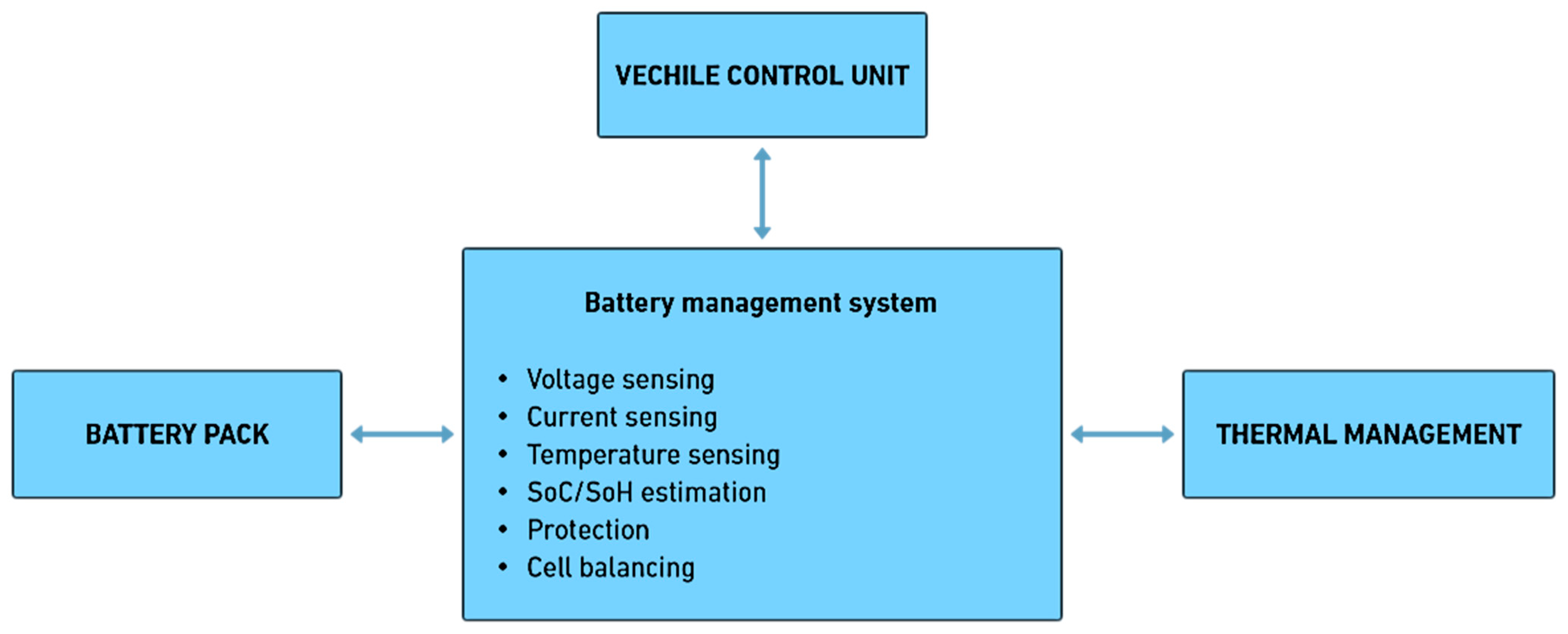



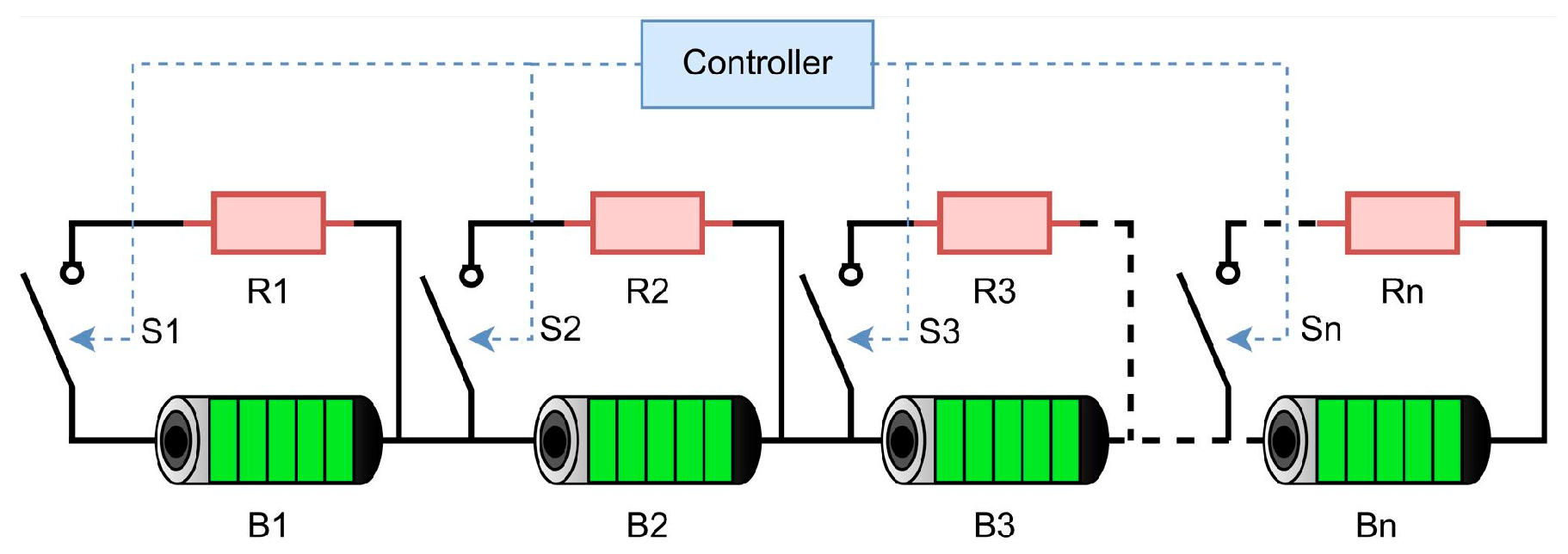
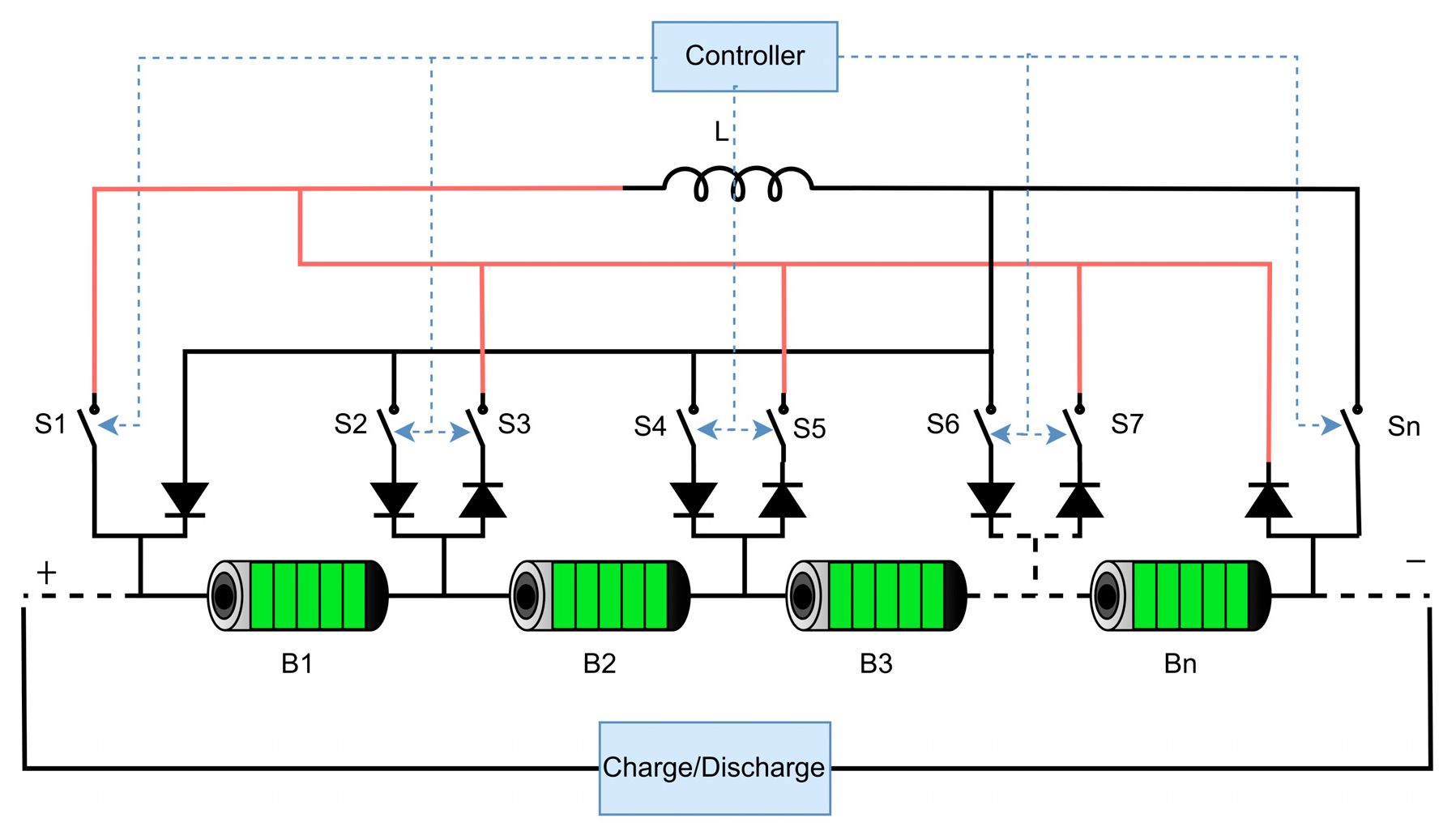
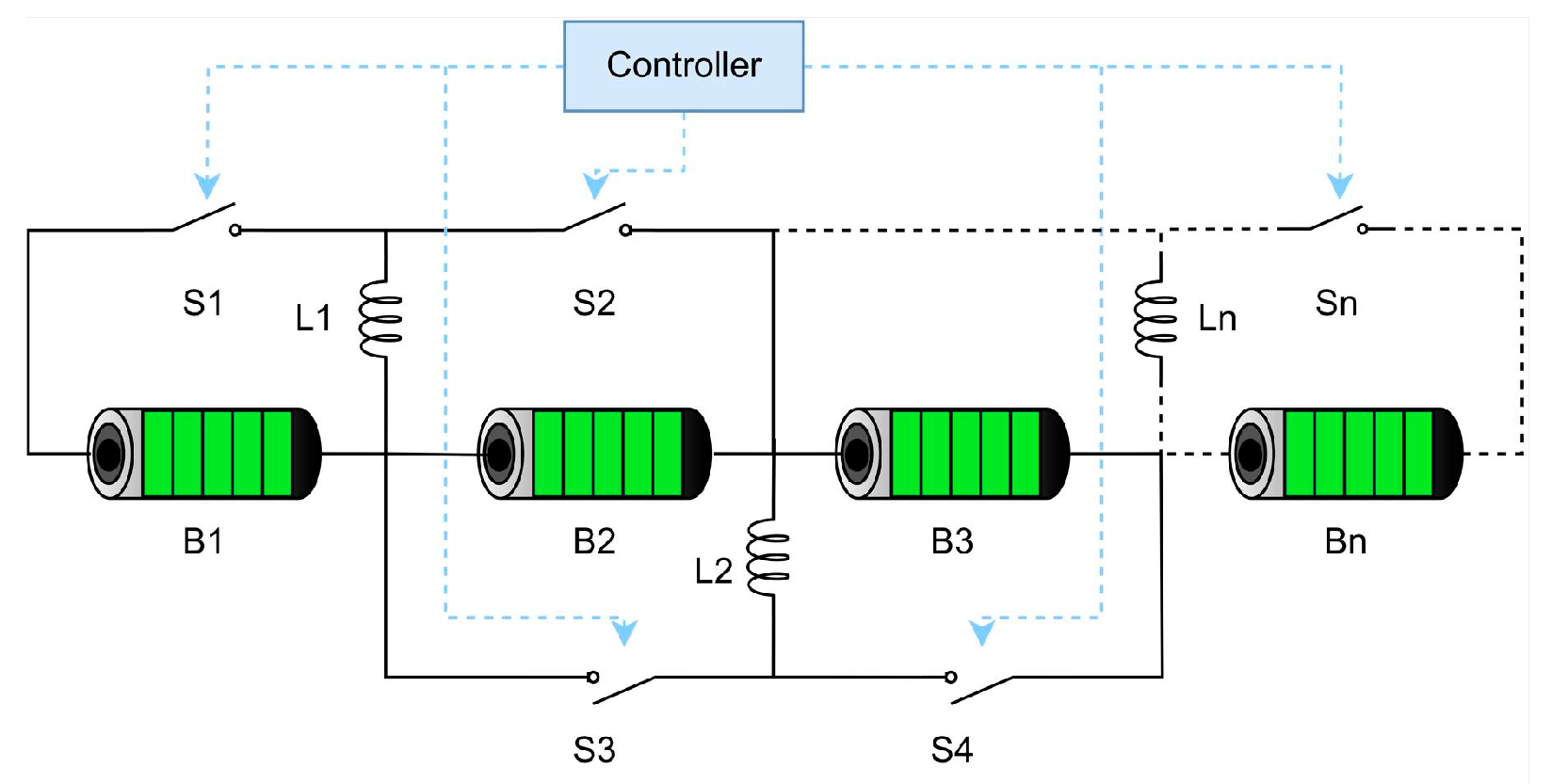


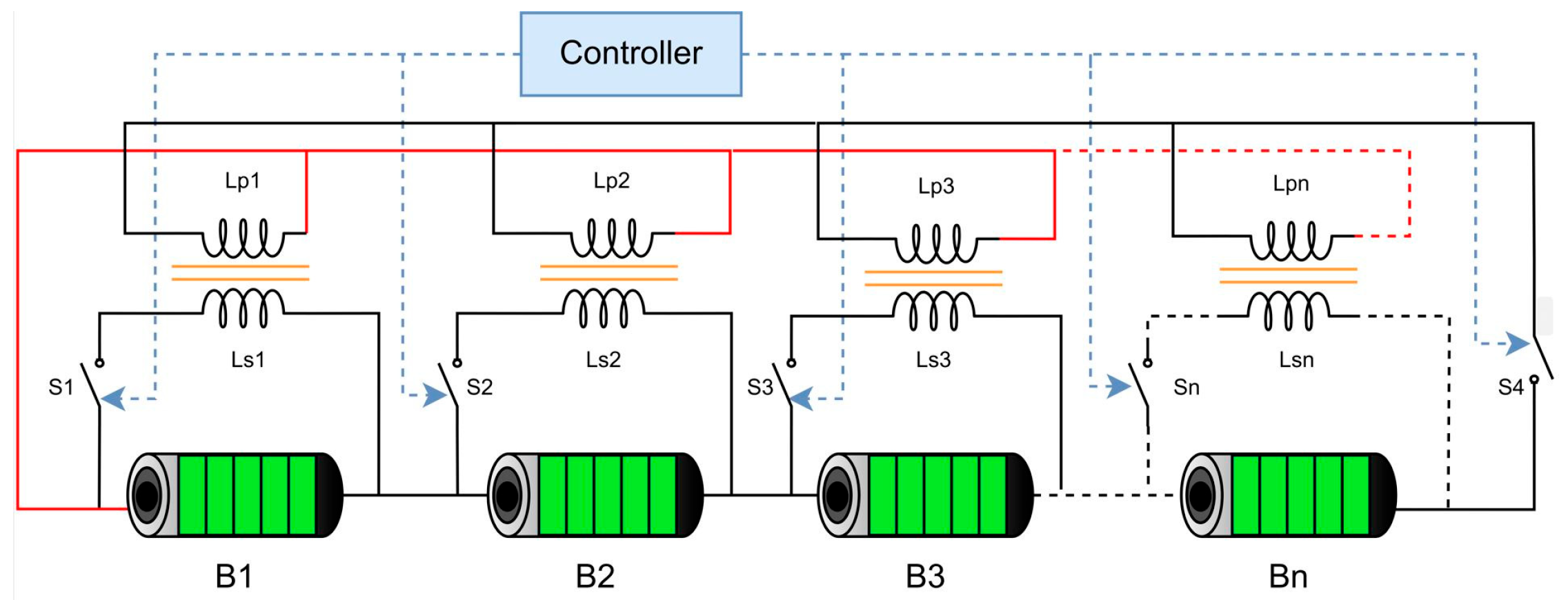
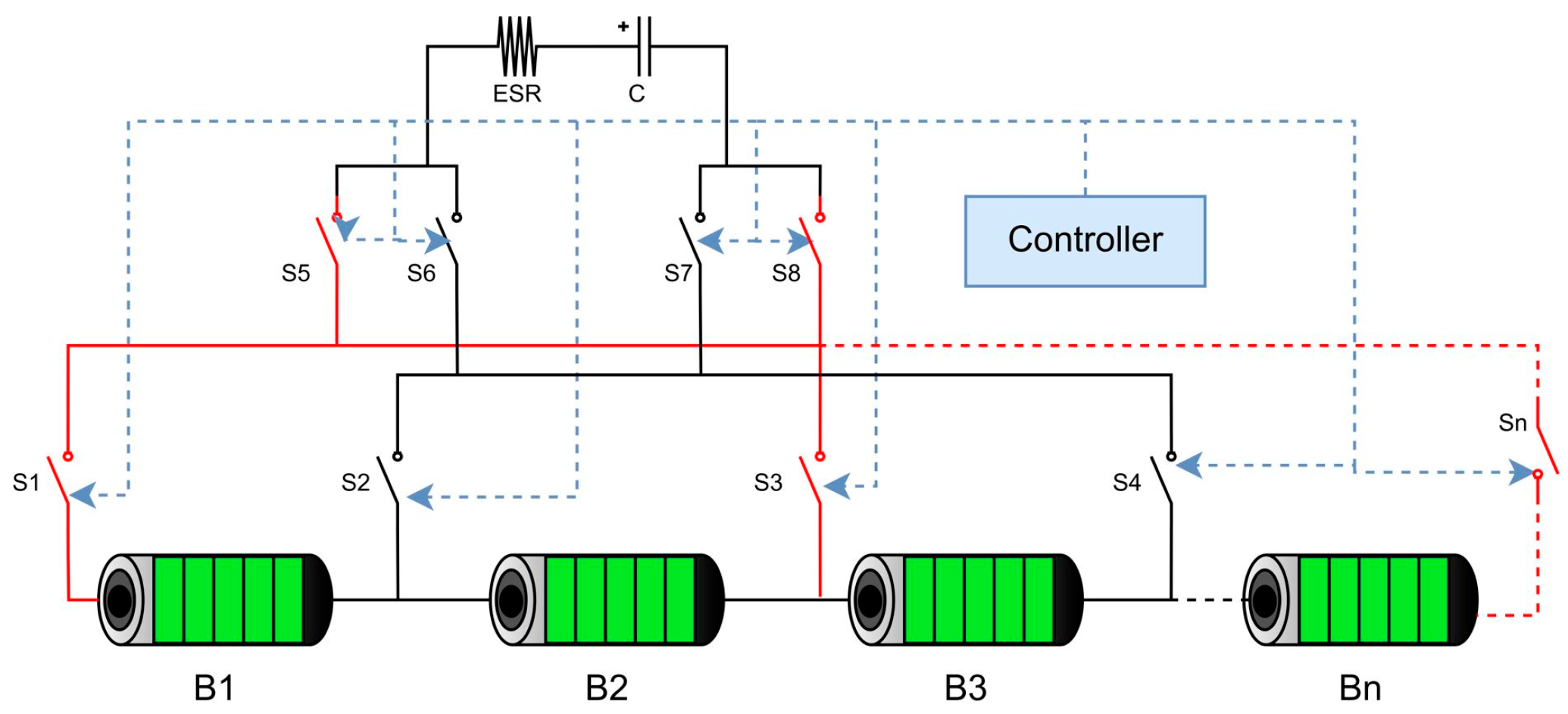



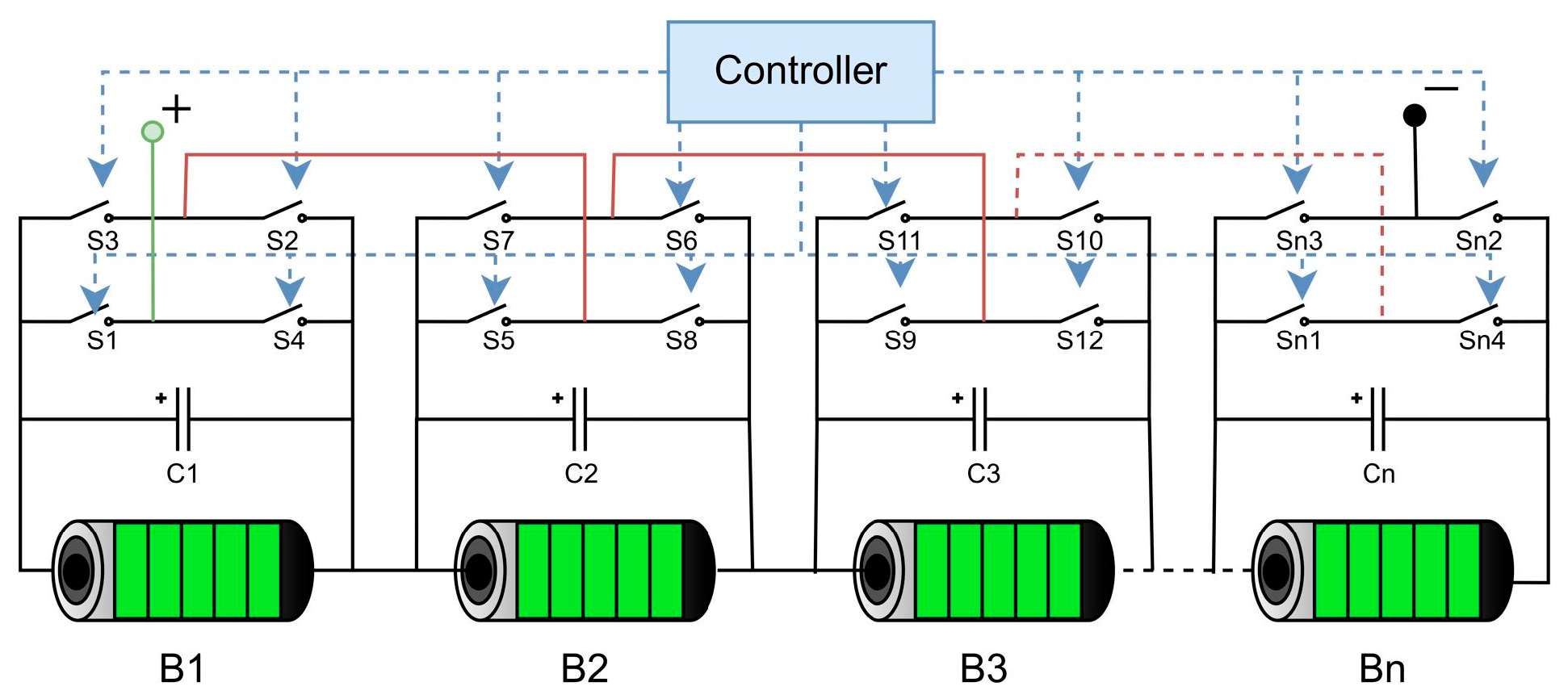

| Refs. | Topologies | Method | Description and Application |
|---|---|---|---|
| [15,16] | Switched shunt resistor | Heat dissipation | Uses resistors to dissipate extra energy as heat from high-energy cells. Common in commercial EVs due to simplicity and low cost. |
| [17,18] | Capacitor-based | Cell-to-cell | Capacitors are used to transfer energy between adjacent cells. Used in some low-power applications (e-bikes and e-scooters) with advanced BMS. |
| [19,20] | Inductor-based | Any Cell to any cell | Uses inductors or transformers to transfer charge between any two cells. NenPower has recently introduced an inductor-based active balancing topology for EVs. |
| [21,22] | Converter-based | Pack-to-cell or cell-to-pack | Uses bidirectional DC–DC converters to move energy between cells or modules. Emerging in modular or large energy storage systems, but still in the prototype stage. |
| [23,24] | Hybrid | Combined | Combines passive and active topologies. It also integrates ML with basic topologies to enhance efficiency and performance. However, they did not find any commercial deployment. |
| Topologies | Components | Method | Advantages/Disadvantages | |||||
|---|---|---|---|---|---|---|---|---|
| R | L | T | C | D | S | |||
| Passive | ||||||||
| Fixed shunting resistor | n | 0 | 0 | 0 | 0 | 0 | Cell to heat | small size, no control, low cost/high power loss, heat management required, overcharge and discharge |
| Switched shunting resistor | n | 0 | 0 | 0 | 0 | n | Cell to heat | small size, simple control, low cost, low switching stress/high power loss, heat management required |
| Active | ||||||||
| Single-inductor | 0 | 1 | 0 | 0 | 2n | 2n | C2P, P2C, C2C, C2P2C | low switching stress/complex control, large size, high cost |
| Coupled inductor | 0 | n−1 | 0 | 0 | 0 | 2n−2 | C2C | low switching stress, moderate cost/complex control, large size |
| Single switched capacitor | 1 | 0 | 0 | 1 | 0 | n + 5 | C2P, P2C, C2C, C2P2C | low switching stress, moderate control, low cost, small size/slow balancing speed |
| Multiple switched capacitors | n−1 | 0 | 0 | n−1 | 0 | 2n | C2C | high balancing speed, small size, moderate cost /high switch count, complex control, increased switching stress |
| Single transformer | 0 | 0 | 1 | 0 | 1 | n + 6 | C2P, P2C, C2P2C | moderate size, moderate cost, low switching stress/complex control, magnetisation loss |
| Multi-winding transformer | 0 | 0 | 1 | 0 | n | 1 | C2P, P2C, C2P2C | small size, moderate control, low cost, low switching stress/magnetisation loss |
| Multiple transformer | 0 | 0 | n | 0 | n | n | C2P, P2C, C2P2C | easy modularised, low switching stress/high cost, complex control, large size, magnetisation loss |
| Single switched capacitor | 1 | 0 | 0 | 1 | 0 | n + 5 | C2P, P2C, C2C, C2P2C | moderate control, low cost, low switch voltage stress/slow balancing speed |
| Multiple switched capacitors | n−1 | 0 | 0 | n−1 | 0 | 2n | C2C | high balancing speed/complex control, high cost, high switch stress |
| Buck–boost converter | 0 | n | 0 | n | 0 | 2n | C2C | low switching stress, high balancing speed/high cost, complex control, large size |
| Quasi-resonant converter | 0 | 2n−2 | 0 | n−1 | 0 | 2n−2 | C2C | low switching stress, medium balancing speed/high cost, complex control, large size |
| Full-bridge converter | 0 | 0 | 0 | n | 0 | 4n | C2C | low switching stress, medium balancing speed/high cost, complex control, large size |
| Bypass | 0 | 0 | 0 | 0 | 0 | 2n | Bypass, no energy transfer | high balancing speed, variable DC link, small size, moderate cost/high switching stress |
| Topologies | Key Features | Control Complexity | Switching Loss | Isolation | Remarks on Suitability for the Application |
|---|---|---|---|---|---|
| Fixed shunting resistor | Continuous dissipation | No control | None | No | Suitable for small-scale, low-cost applications (e-bikes, power tools) |
| Switched shunting resistor | Controlled dissipation | Very Low | Low | No | Commonly used in commercial EVs and small-scale energy storage systems |
| Single inductor | Single cell balancing at once | Low | High | No | Suitable for modular battery packs (advanced BMS for EV and energy storage) |
| Coupled inductor | Multiple cells balancing, which increases balancing speed | Medium | High | Partial | Suitable for modular battery packs (advanced BMS for EV and energy storage) It allows multiple energy transfers for faster balancing speed |
| Single Switched Capacitor | Single cell balancing at once | Low | Moderate | No | Suitable for EV battery packs due to its compact design |
| Multiple Switched Capacitors | Multiple cells balancing, which increases balancing speed | Medium | High | No | EV battery packs are suitable due to their compact design. They allow multiple energy transfers for faster balancing speed |
| Single transformer | Provide isolation with single-cell energy transfer | Medium | Moderate | Yes | Not suitable for EV application due to high component count, and extremely complex control, magnetisation, and switching losses. |
| Multi-winding transformer | Multiple cells balancing with isolation | High | Very Low | Yes | Not suitable for EV application due to high component count, and extremely complex control, magnetisation, and switching losses. |
| Multiple transformer | Multiple cells balancing with modular isolation | High | Low | Yes | Not suitable for EV application due to high component count, and extremely complex control, magnetisation, and switching losses |
| Buck–boost converter | Bidirectional energy transfer to provide faster balancing | High | High | Partial | Converter-based topologies face numerous challenges in terms of control complexity, large size, and thermal management |
| Quasi-resonant converter | Soft switching for low electromagnetic interference | Very High | High | Partial | Converter-based topologies face numerous challenges in terms of control complexity, large size, and thermal management |
| Full-bridge converter | Bidirectional balancing for modular BMS for high power | Very High | Very High | Yes | Converter-based topologies face numerous challenges in terms of control complexity, large size, and thermal management |
| Bypass | Bypass a weak capacity cell or module for balancing | low | High | No | Suitable for EV application, but it increases control complexity for the inverter and charger |
| Ref. | Basic Cell Balancing Topology | ML Technique | Key Benefits | Quantitative Metrics |
|---|---|---|---|---|
| [100] | Buck–boost converter | Deep Q-Network | Advanced control algorithms, achieves faster balancing | Cell balancing is achieved from ±10% in capacity with a low penalty of −1.6127 on average over the 1000 episodes |
| [101] | Passive switched resistor | Back-propagation neural network (BPNN), radial basis neural network (RBNN), and long short-term memory (LSTM) | Estimating optimum resistor values to reduce power loss, achieving faster balancing, and reducing temperature | Conventional balancing time is reduced from 60 min to 30 min. power loss is reduced from 1.1 Wh to 0.4 Wh. LSTM is better with mean absolute error, MAE = 0.066. BPNN is better the RBNN with MAE = 0.1276 |
| [102] | DC-DC converter | Multi-agent reinforcement learning (MARL) training with the trust region policy optimisation (TRPO) algorithm | Maximises pack capacity while minimising SOC variations | Average SOC variance is reduced by 61.20%. Usable capacity is increased from 3298 mAh to 4203 mAh, which increases the driving range by 8 miles. |
| [103] | Buck–boost converter | Markov decision process (MDP) and deep reinforcement learning (RL) | Optimal energy management control is achieved with RL. Presents a model-free energy management strategy | SOC imbalance is reduced from 50% to approximately 0%. Coulomb counting technique to estimate SOC. |
| [104] | active cell balancing | Machine learning models, including Predictive Analytic Recurrent Neural Networks (PA-RNN), Deep-Q Networks (DQN), Amortised-Q Networks (AQN), Adaptive Neural Networks (ADNN), and Automotive Controllers (AC) | Improved balancing efficiency, response time, and thermal stability. PA-RNN used for SOC error minimisation, DQN for adaptive control, AQN for quick decision, ADNN for accuracy, and AC for enhanced BMS efficiency. | SOC errors show ADNN (−1.04%), achieved the lowest average error compared with PA-RNN (−1.15%), DQN (−3.15%), AQN (−3.25%), and AC (−2.65%). |
| [105] | Bypass topology | Machine learning, multi-dimensional K-nearest control algorithm (MKNA) | Improved cell balancing time, reduced temperature stress on specific cells by spreading the temperature effect on others. | The temperature spreading comparison of the MKNA method shows better performance instead of SOC sorting and provides peaks. However, for 25 series cells with an initial maximum 20% imbalance, MKNA balances the cells in 2000 sec, which is a higher time than SOC sorting, which is 1600 sec. |
Disclaimer/Publisher’s Note: The statements, opinions and data contained in all publications are solely those of the individual author(s) and contributor(s) and not of MDPI and/or the editor(s). MDPI and/or the editor(s) disclaim responsibility for any injury to people or property resulting from any ideas, methods, instructions or products referred to in the content. |
© 2025 by the authors. Licensee MDPI, Basel, Switzerland. This article is an open access article distributed under the terms and conditions of the Creative Commons Attribution (CC BY) license (https://creativecommons.org/licenses/by/4.0/).
Share and Cite
Ashraf, A.; Ali, B.; Al Sunjury, M.S.A.; Tricoli, P. A Comprehensive Review of the Art of Cell Balancing Techniques and Trade-Offs in Battery Management Systems. Energies 2025, 18, 3321. https://doi.org/10.3390/en18133321
Ashraf A, Ali B, Al Sunjury MSA, Tricoli P. A Comprehensive Review of the Art of Cell Balancing Techniques and Trade-Offs in Battery Management Systems. Energies. 2025; 18(13):3321. https://doi.org/10.3390/en18133321
Chicago/Turabian StyleAshraf, Adnan, Basit Ali, Mothanna S. A. Al Sunjury, and Pietro Tricoli. 2025. "A Comprehensive Review of the Art of Cell Balancing Techniques and Trade-Offs in Battery Management Systems" Energies 18, no. 13: 3321. https://doi.org/10.3390/en18133321
APA StyleAshraf, A., Ali, B., Al Sunjury, M. S. A., & Tricoli, P. (2025). A Comprehensive Review of the Art of Cell Balancing Techniques and Trade-Offs in Battery Management Systems. Energies, 18(13), 3321. https://doi.org/10.3390/en18133321







